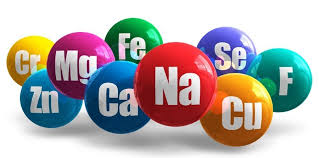Micronutrients and their importance in nutrition
Micronutrients carry out their physiological functions when present in the body in small amounts (milligrams and micrograms) and play specific biological roles as components of enzyme systems (cofactors), factors of gene and metabolic regulation of vital cellular mechanisms.
Iron. It is necessary for the biosynthesis of compounds that ensure respiration, hematopoiesis, is involved in immunobiological and redox reactions, is a component of the cytoplasm, cell nuclei and a number of enzymes.
Iron assimilation is hindered by oxalic acid and phytin. B12 and ascorbic acid are required for assimilation.
Need: men - 10 mg per day women -18 mg per day.
With iron deficiency, anemia develops, gas exchange is disturbed,
cellular respiration.
Found in: by-products, meat, eggs, beans, vegetables, berries, bread products. However, in an easily digestible form of iron is found only in meat products, liver, egg yolk.
Zinc. This element plays an important role in the growth and development of the body, immune response, functioning of the nervous system and insular apparatus, and reproduction. At the cellular level, the functions of zinc can be divided into three types: catalytic, structural, and regulatory.
The main sources of zinc in the diet are seafood, meat, eggs, nuts and legumes.
To meet the daily requirement of zinc, it is necessary to include in the diet an appropriate amount of meat and meat products, milk, cheese, bread and cereals, potatoes and vegetables on a daily basis. Also regularly, several times a week, should be used in the diet seafood, nuts, seeds, eggs.
The physiologic need for zinc for a healthy adult is 15 mg/day. A biomarker of this element is the level of zinc in blood serum and daily urine: its norm is 10.7...22.9 µmol/l in serum and 0.1...0.7 mg in urine.
Iodine is a non-metallic trace element used by the body to synthesize thyroid hormones: triiodothyronine (T3) and thyroxine (T4), which regulate growth, development, reproduction and metabolism through gene expression. The thyroid gland must capture about 60 µg of iodine per day for adequate hormone synthesis.
Molybdenum. This element participates as a molybdenum cofactor in the metabolism of carbon, nitrogen and sulfur not only in the human body, but also globally in the entire ecosystem. Molybdenum is quite widely represented in food products. A mixed diet in developed countries usually contains 50 to 110 µg of molybdenum. The greatest amount is present in legumes, as well as in cereals and nuts Animal products, fruits and vegetables are generally poor in this element. The physiologic level of need for molybdenum is not precisely established. For a healthy adult, 75-250 µg/day is considered a safe level of intake.
Chromium. It belongs to trace elements with a dual biological effect on the human body. In the trivalent state, chromium is an essential nutritional factor and it is in this form that it is present in food as its natural component. Entering the body in the six-valent form (as a product of industrial anthropogenic activity), chromium is a dangerous toxicant with mutagenic and carcinogenic effects.
Physiological activity of chromium is associated with its participation in the regulation of glucose metabolism associated with the action of insulin. Chromium is absorbed from food by no more than 1%. Sources of chromium in the diet are meat products, fish, poultry, cereals and legumes, some vegetables and fruits. Chromium is almost completely lost during deep processing of food raw materials - it is very little in sugar, flour of the highest purity and cereals, polished rice, as well as in eggs and milk.
There is relatively much cobalt in nuts, legumes and cocoa - from 12 to 20 µg per 100 g of product. Potatoes, tomatoes, onions, mushrooms, green salad, pears, oat groats and millet contain from 4 to 10 micrograms of cobalt per 100 g of product. In animal food products, its content directly correlates with the amount of vitamin B|2. A significant source of cobalt is drinking water. The requirement for cobalt has not been accurately established.
The imbalance of minerals and trace elements belongs to the most important problems of nutritional hygiene and requires mandatory correction. In this case, it is necessary to correctly assess the real level of the body's supply of certain minerals, taking into account that for a healthy adult nutritional deficiency of one or another micronutrient, as a rule, is associated with obvious errors in the diet.
In most cases, micronutrient imbalance develops with long-term insufficient consumption of food products from the group of daily use and is associated with an incorrect stereotype of food choices.
The first step in correcting mineral imbalance is to normalize the structure of the diet using traditional food products. Additional fortification of foodstuffs with minerals can apparently be considered as a possible hygienic technique only for a limited number of substances. It can be used with relative population safety, for example, for calcium.
The safety of enrichment of a wide range of products with selenium, copper, zinc and other trace elements raises serious doubts, especially in modern environmental conditions, when their concentrations in the environment are progressively increasing.
In this regard, individually determined deficiencies of these micronutrients and a number of other elements with suspected es- sensitivities can be more effectively and safely corrected by appropriate nutritional supplementation.
Sharifzoda Firuza Jabor
Assistant professor of public health
and medical statistics and history of medicine course
translated Ismoilov R.

